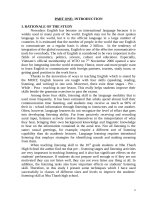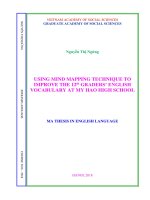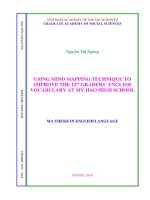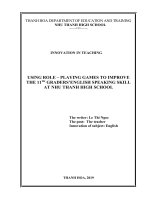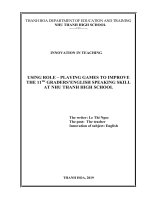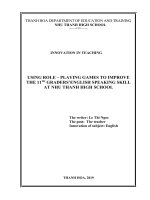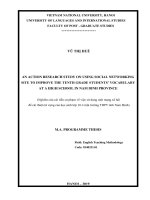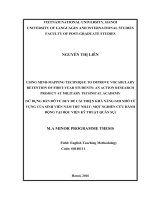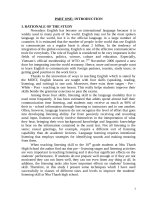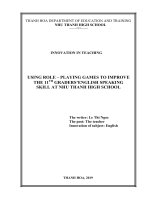Using mind mapping technique to improve the 12th graders’ english vocabulary at my hao high school
Bạn đang xem bản rút gọn của tài liệu. Xem và tải ngay bản đầy đủ của tài liệu tại đây (2.39 MB, 133 trang )
NGUYỄN THỊ NGỪNG
VIETNAM ACADEMY OF SOCIAL SCIENCES
GRADUATE ACADEMY OF SOCIAL SCIENCES
Nguyễn Thị Ngừng
COVER PAGE 2
ENGLISH LANGUAGE
USING MIND MAPPING TECHNIQUE TO
IMPROVE THE 12th GRADERS’ ENGLISH
VOCABULARY AT MY HAO HIGH SCHOOL
MA THESIS IN ENGLISH LANGUAGE
COURSE: 2016 – 2018
HANOI, 2018
VIETNAM ACADEMY OF SOCIAL SCIENCES
GRADUATE ACADEMY OF SOCIAL SCIENCES
Nguyễn Thị Ngừng
USING MIND-MAPPING TECHNIQUE TO
IMPROVE THE 12th GRADERS’ ENGLISH
VOCABULARY AT MY HAO HIGH SCHOOL
Field: English Language
Code: 8220201
Supervisor: Đặng Nguyên Giang, Ph.D.
HANOI, 2018
DECLARATION BY AUTHOR
I, the undersigned, hereby certify that the thesis entitled “Using Mindmapping Technique to Improve the 12th Graders’ English Vocabulary at My
Hao High School” is the result of my own research for the Degree of Master of
Arts in English Language. The substance of the thesis has not, wholly or in part,
been submitted for any other degree to any other universities or institutions.
Except where reference has been made in the text, this thesis contains no
material previously published or written by another person.
The study reported in this thesis was approved by Graduate Academy of
Social Sciences.
Author’s Signature
Nguyễn Thị Ngừng
Approved by
SUPERVISOR
Đặng Nguyên Giang, Ph.D.
Date:……………………
i
ACKNOWLEDGEMENTS
Although only one name appears as the author of this work, writing a
thesis is indeed a collaborative effort. I would like to express my sincere thanks
to the many people who made it possible.
First of all, I would like to express my sincere gratitude and deep
appreciation to Đặng Nguyên Giang, Ph. D, my supervisor, for his helpful and
warm encouragement as well as his insightful comments on my work from the
beginning to the end of the study.
Next, the completion of this thesis would not have been possible without
the cooperation from the respondents (ninety 12th graders at My Hao High
School) who have been willing to take part in the study. I am very grateful to all
of them for providing detailed information for the analysis of the study.
In addition, I would like to thank all of the lecturers who gave me
interesting lessons, dedication and advice during my study at Graduate
Academy of Social Sciences.
I also offer my special thanks to my colleagues and friends whose support
and encouragement help me to have this thesis accomplished.
Last but not least, I must express my gratitude to my family. It is their
endless love and expectations that have motivated me to complete this thesis. I
am immensely thankful for all the assistance they have given me.
ii
TABLE OF CONTENTS
CHAPTER 1: INTRODUCTION ....................................................................... 1
1.1. Rationale.......................................................................................................... 1
1.2. Aims of the Study ........................................................................................... 2
1.3. Research Questions ........................................................................................ 2
1.4. Scope of the Study.......................................................................................... 3
1.5. Significance of the Study ............................................................................... 4
1.6. Research Methods .......................................................................................... 5
1.7. Structure of the Study..................................................................................... 6
CHAPTER 2: LITERATURE REVIEW ........................................................... 7
2.1. Vocabulary ..................................................................................................... 7
2.1.1. Vocabulary Defined..................................................................................... 7
2.1.2. Vocabulary Classified ................................................................................. 8
2.1.3. Aspects of Learning Vocabulary ................................................................. 9
2.1.4. Vocabulary Tests Defined ......................................................................... 13
2.2. Mind-mapping Technique ............................................................................ 15
2.2.1. Mind-mapping Technique Defined............................................................ 15
2.2.2. Mind-mapping Classified .......................................................................... 17
2.3. Mind-mapping Technique in Teaching and Learning Vocabulary .............. 21
2.4. Advantages and Disadvantages of Using Mind-mapping Technique .......... 26
2.5. Previous Research ........................................................................................ 28
2.5.1. Previous Studies Carried out in Foreign Countries ................................. 28
2.5.2. Previous Studies Carried out in Vietnam .................................................. 29
2.6. Chapter Summary ......................................................................................... 30
CHAPTER 3: METHODOLOGY .................................................................... 32
3.1. Research Setting ........................................................................................... 32
3.2. Participants ................................................................................................... 33
3.3. Data Collection Instruments ......................................................................... 34
3.3.1. Vocabulary Tests ....................................................................................... 34
3.3.2. Questionnaires .......................................................................................... 35
iii
3.3.3. Interviews .................................................................................................. 36
3.4. Research Design ........................................................................................... 37
3.5. Research Procedures .................................................................................... 40
3.5.1. Phase 1 ...................................................................................................... 40
3.5.2. Phase 2 ...................................................................................................... 40
3.5.3. Phase 3 ...................................................................................................... 41
3.5.4. Phase 4 ...................................................................................................... 42
3.6. Data Analysis ............................................................................................... 43
3.7. Chapter Summary ......................................................................................... 45
CHAPTER 4 FINDINGS AND DISCUSSIONS ............................................. 46
4.1. Data Analysis from Questionnaires ............................................................. 46
4.2. Data Analysis from Tests ............................................................................. 54
4.3. Data Analysis from Interviews..................................................................... 59
4.4. Chapter Summary ......................................................................................... 63
CHAPTER 5: CONCLUSION .......................................................................... 65
5.1. Recapitulation............................................................................................... 65
5.2. Concluding Remarks .................................................................................... 66
5.3. Implications .................................................................................................. 69
5.4. Limitations and Suggestions for Further Studies ......................................... 70
5.4.1. Limitations ................................................................................................. 70
5.4.2. Suggestions for Further Studies ................................................................ 70
REFERENCES ..................................................................................................... 72
APPENDIX 1: Questionnaires ................................................................................I
APPENDIX 2: Semi-structured interview questions ........................................... III
APPENDIX 3: Answers for the interviews........................................................... V
APPENDIX 4: The students’ opinions about the teacher’s activities .............. VIII
APPENDIX 5: Positive attitude of students toward mind mapping technique ... X
APPENDIX 6: The students’ positive evaluation on the effectiveness of the MM
technique ............................................................................................................... X
APPENDIX 7: Pre-test .........................................................................................XI
iv
APPENDIX 8: Post-test 1 ................................................................................. XIII
APPENDIX 9: Post-test 2 .................................................................................. XV
APPENDIX 10: Mean Score of Tests ............................................................. XVII
APPENDIX 11: Ranges of Scores ................................................................. XVIII
APPENDIX 1: Key to the Tests ........................................................................ XIX
APPENDIX 13: Textbook - Unit 6 .................................................................... XX
APPENDIX 14: Listening Tapescript ............................................................. XXX
APPENDIX 15: Lesson Plan ......................................................................... XXXI
v
ABSTRACT
The principal objective of the present research is to investigate the 12th
graders’ attitudes towards mind-mapping technique used in vocabulary teaching
and evaluate the effectiveness of mind-mapping technique applied to vocabulary
teaching. To do so, 90 students who are from two classes 12A2 and 12A8 took
part in this study. Pre-test, post-tests, a questionnaire and an interview are
chosen as the data collection instruments to find out the effect of the
intervention. In this study, the writer as teacher and observer tried to apply
Mind-mapping techniques to improve the students’ vocabulary mastery. There
are four phrases used in this study namely planning, action, observation and
reflection (from phrase 1 to phrase 4 respectively). The results of pre-test and
post-tests were used to know the effectiveness of Mind-mapping techniques on
students’ vocabulary mastery. It was indicated through improvement the mean
score of each test. The mean score of pre-test was 40.11, that of post-test I was
63. 33 whereas the mean score of post-test II was 59.33. The findings of the
study reveal that mind-mapping technique is one of the good ways to improve
the students’ vocabulary in particular and English teaching and learning in
general.
vi
LIST OF TABLES
Table 1: The students’ opinions about the teacher’s activities............................ 47
Table 2: Positive attitudes of the students toward mind-mapping technique ...... 48
Table 3: The students’ positive evaluation on the effectiveness of the mindmapping technique ............................................................................................... 50
Table 4: Mean score of tests ................................................................................ 55
Table 5: Comparison of distribution of score range ………………………………58
vii
LIST OF FIGURES
Figure 1: An example of Mind-mapping .............................................................. 15
Figure 2: An example of a network tree .............................................................. 18
Figure 3: An example of an event chain .............................................................. 19
Figure 4: An example of a cycle concept map ..................................................... 20
Figure 5: An example of hayfork ......................................................................... 21
Figure 6: An example of thorn fish ...................................................................... 21
Figure 7: An example of cluster ........................................................................... 21
Figure 8: An example of variation ....................................................................... 21
Figure 9: A Mind-mapping about City................................................................. 25
Figure 10: A Mind-mapping about Animals ........................................................ 26
Figure 11: Procedure of the research .................................................................. 43
Figure 12: It is interesting to learn English vocabulary with mind-mapping
technique .............................................................................................................. 49
Figure 13: Students’ opinions on pleasure when learning with mind-mapping
technique .............................................................................................................. 49
Figure 14: Students’ opinions on the creativity when learning with mindmapping technique ............................................................................................... 50
Figure 15: Students’ opinions on the statement “I find it easy to remember new
words.” ................................................................................................................. 52
Figure 16: Students’ opinions on the statement “The activities help retain
vocabulary longer” ............................................................................................. 52
Figure 17: Students’ opinions on the statement “The activities help activate
prior knowledge” ................................................................................................. 53
Figure 18: Mean score of the tests ....................................................................... 57
Figure 19: Distribution in results of the three tests ............................................. 58
Figure 20: Proportion of students find Mind-mapping techniques difficult........ 62
Figure 21: The desire to learn with mind mapping technique............................. 63
viii
LIST OF ABBREVIATIONS USED IN THE THESIS
GCSE : General Certificate of Secondary Education
T
: Teacher
Sts
: Students
AR
: Action research
ix
CHAPTER 1
INTRODUCTION
1.1. Rationale
In today’s global world, the importance of English cannot be denied and
ignored. It has been playing a major role in many sectors including medicine,
engineering, education, aviation, etc. It is the language of science and
technology. It is the official language in a large number of countries. English
language, therefore, is believed to be used to access to every field of life. It is
English that is used to communicate internationally.
In acquiring a foreign language, vocabulary plays a crucial part. It is one
element that links the four skills (speaking, listening, reading and writing) all
together. When talking about the importance of vocabulary, it was noted by
Wilkins (1972) that: "without grammar little can be conveyed, without
vocabulary nothing can be conveyed." Indeed, people need to use words in order
to express themselves in any language. In order to communicate well in a
foreign language, anyone should acquire an adequate number of words and
should know how to use them accurately.
Before 1970, little attention was paid to vocabulary teaching and learning.
It means that teaching vocabulary was just considered as an addition to teaching
grammar or simply a by-product of language teaching and commucative
functions. However, some scholars of language acquisition no longer talk about
the four language skills, but nine skills. These other five skills are vocabulary,
spelling, grammar, pronunciation and study skills. Therefore, the role of
vocabulary knowledge has been recognized by theorists and researchers since
1990.
Besides, in my experience as a teacher of English, I noticed that my
students usually find it difficult to speak English fluently. They usually consider
speaking and writing activities (productive skills) exhausting because they keep
on using the same words and expressions, so very soon their conversation is
abruptly interrupted due to missing words. For the same reason, their receptive
1
skills (listening and reading) are not good either. The main reason for such
problems is the lack of vocabulary. Other students are faced with the problem of
forgetting the words right after the teacher has elicited their meaning or after
having looked them in the dictionary. This is also a cause of the lack of
vocabulary.
Recognizing the importance of vocabulary, I myself understand that the
teacher has an essential role in helping students to improve their vocabulary.
To the best of my knowledge, there have not been any studies concerning
Mind-mapping technique in vocabulary teaching carried out at My Hao high
school before. Therefore, the author of the present study, a teacher of English,
has decided to conduct a study named “Using Mind-mapping Technique to
Improve the 12th Graders’ English Vocabulary at My Hao High School”. The
findings of the study, if done well, would be original.
1.2. Aims of the Study
The aim of the study is to improve the 12th graders’ English vocabulary at
My Hao high school. In order to achieve the aim, the study is expected to reach
the objectives as follows:
- Uncovering the 12th graders’ attitudes towards mind-mapping technique
used in vocabulary teaching;
- Evaluating the effectiveness of mind-mapping technique applied to
vocabulary teaching.
1.3. Research Questions
The objectives of the study can be elaborated into the research questions
as follows:
- How is mind-mapping technique used in vocabulary teaching assessed
by the 12th graders at My Hao High School?
- What is the effectiveness of mind-mapping technique on the 12th graders’
English vocabulary outcome at My Hao High School?
2
1.4. Scope of the Study
The focus of the study is using mind-mapping technique to improve the
12th graders’ English vocabulary at My Hao high school. Hence, the study could
not cover all aspects in vocabulary teaching. It only focused on the use of mindmapping as a technique to help enhance the 12th graders’ vocabulary at My Hao
high school.
The subjects of the study are 90 male and female students coming from
class 12A2 and 12A8. The age of those 90 students ranges from 17 to 18. They
are going to be the participants and respondents to survey questionnaires, trial
lessons and tests.
The action plan was implemented in 5 months from October 2017 to
February 2018, during the academic school year (2017-2018) at My Hao high
school.
TIME
RESEARCH ACTIVITIES
October 2017
-
(week 1: from 2nd to 7th)
The
researcher
identified
the
prepared
the
problems to be changed
October 2017
-
The
researcher
(week 2,3
instructional strategy (mind-mapping
From 9th to 21st)
techniques) which were theoretically
effective to improve the situation and
solve the problem.
October 2017
- Students were given the pre-test
(week 4: From 23rd to 28th)
before the treatment in order for the
researcher to evaluate the student’s
vocabulary knowledge.
November 2017
- The data collected from the pre-test
(week 1: From 30th Oct to 4th Nov)
were analyzed to form a hypothesis.
November 2017
- The researcher made a detailed plan
(week 2,3: From 6th to 18th )
of what she intended to implement.
- Researcher’s intervention
From November 2017 (week 4)
3
to December (week 1,2)
From 20th Nov to 16th December)
December
- The first post-test was given to
(week 2: From 11th to 16th)
students to determine the effectiveness
of the intervention.
December
- The students were asked to fill in the
(week 1,2: From 4th to 16th )
questionnaire to figure out students’
attitudes towards teacher’s activities.
- The interviews were conducted with
15 students.
January 2018
- The second post-test was given to
(week 1: From 1st to 6th )
students to determine the effectiveness
of the intervention.
January 2018
- The data collected from the two post-
(week 2,3,4: From 8th to 27th)
tests and questionnaire, interviews
were analyzed to evaluate the students’
opinions about the treatment used and
to
identify
if
there
are
any
improvements.
-
The
researcher
evaluated
the
effectiveness of the treatment and
identified the results of the research.
From February 2018
The researcher work with her thesis
1.5. Significance of the Study
Theoretically, the findings of this research will reaffirm and reinforce the
effectiveness of mind-mapping technique in previous studies. Besides, the
teachers’ skill in using mind-mapping technique to improve the student’s
vocabulary is expected to be sharpened and developed. In addition, the findings
4
of this research will be considered as reference to other researchers who want to
study mind-mapping technique more intensively in teaching vocabulary.
Practically, the researcher hopes that the results of the thesis may be
practically beneficial to not only the researcher herself but also to the other
teachers, the students and My Hao high school. Firstly, to the researcher, after
carrying out this research, the researcher will have deeper and broader
understanding of the theory and techniques of vocabulary teaching, especially
Mind-mapping technique. Secondly, to the teachers, the findings of this research
can support the teachers of English at My Hao high school to apply this strategy
in teaching vocabulary, along with many other methods, so that not only the 12th
graders but also the rest students may be beneficial. Moreover, the teacher can
put aside their traditional methods in teaching English language particularly in
teaching vocabulary. They can use this new strategy to make the students more
interested in learning process. In addition, the teachers may not confuse in
choosing an appropriate technique to teach different kinds of vocabulary.
Thirdly, to the students, the positive results of this research are hoped to help the
students enrich their vocabulary. In addition, learning vocabulary through Mindmapping technique can make the students more excited; more interested in
doing their tasks and retain vocabulary in a long-term. Then, they can recall
many kinds of vocabulary effectively. Finally, to My Hao high school, the
school leaders can give the recommendation to the teachers in order to use the
appropriate techniques or strategies in teaching and learning vocabulary.
Therefore, the teachers will master more teaching skills and will bring benefit to
the school.
1.6. Research Methods
The purpose of this research is to find out whether mind-mapping
technique has any positive effects on the 12th graders’ improvement and
retention of vocabulary and explore the students’ attitudes toward this technique.
Besides, I myself - the researcher - would like to improve my students' learning
skill and my professional performance. Therefore, it is hoped to be a practical
5
action research project because its purpose is to research a specific school
situation with a view toward improving practice, to focus narrowly on a specific
problem and to be undertaken by an individual teacher within a high school.
In order to address the two research questions, both qualitative and
quantitative methods are exploited in this action research. The data are collected
via survey questionnaires, interviews and tests.
1.7. Structure of the Study
In addition to the references and appendices, the thesis is composed of
five chapters:
CHAPTER 1: Introduction
CHAPTER 2: Literature Review
CHAPTER 3: Methodology
CHAPTER 4: Findings and Discussions
CHAPTER 5: Conclusion
6
CHAPTER 2: LITERATURE REVIEW
This chapter reviews the literature relevant to the study including an
overview of vocabulary, mind-mapping, the effectiveness as well as the benefits
of applying mind-mapping technique in teaching and learning vocabulary.
Besides, the researcher also points out the literature gap and explains the reason
why to conduct the present study.
2.1. Vocabulary
Vocabulary is the knowledge of words and word meanings. As Stahl
(2005) puts it, "Vocabulary knowledge is knowledge; the knowledge of a word
not only implies a definition, but also implies how that word fits into the world."
Vocabulary knowledge is not something that can ever be fully mastered; it is
something that expands and deepens over the course of a lifetime. Instruction in
vocabulary involves far more than looking up words in a dictionary and using
the words in a sentence.
2.1.1. Vocabulary Defined
According to Webster (1994), vocabulary is the list of words which is often
used in every aspect of life and words are usually arranged alphabetically with
an equivalent definition. To be more details, vocabulary is often explained or
translated, depending on the word stock at the command of an individual for the
use of this person in particular work, language or branch of subject, etc.
Additionally, Lado (1994) defined vocabulary as a form of expression with
associated with the meaning and content of words. Meanwhile, it was also
defined by Scrivener (1994) that vocabulary could be considered as a powerful
meaning carrier because when a student identifies the importance of the
vocabulary in communication and learning, they may reasonably intend to get,
receive and accept a working knowledge of a great amount of words.
Another significant thing to be considered for teachers when making work
of vocabulary is the difference between receptive and productive vocabulary.
7
According to S. Thornbury (2002), in general, there are several difficulties when
learners access vocabulary of a foreign language, and they are:
Creating the accurate connection between the form and meaning of words
during the process of understanding the target language; for example,
separating the meaning of the words related to the topic.
Using the exact word form for the intentional meaning when producing
language.
In brief, there are many different points of view about vocabulary. Having
mentioned these definitions, the researcher decided to use that of Webster
(1994) in this study because this definition from this scholar is more appropriate
and useful to use in the study.
2.1.2. Vocabulary Classified
According to Scrivener (1974), vocabulary can be divided into two types,
including productive (active vocabulary) and receptive (passive vocabulary).
Particularly, productive vocabulary is the group of words which are often used
in spoken language, or daily conversation. This type of vocabulary requires
good pronunciation – saying the sounds and stress of the words correctly – so
that the dialogue can be carried out smoothly. Meanwhile, receptive vocabulary
is the use of words that we can identify and understand how to use; but we do
not use it intentionally in conversation or other purposes.
Additionally, it is raised by Hendrich (1988, p.131) that, vocabulary
classification is possible to maintain from different viewpoints: formal (for
example word classes); mechanical (according to the frequency); semantic, that
is according to the relationships of language marking to off-language reality or
according to the relationships of meaning (synonyms, antonyms, etcetera); or
from the grammatical viewpoint, mainly paradigmatic, which is grouping words
together according to the same grammatical characteristics.
8
Another classification by Judy K. Montgomery (from the book: The Bridge
of Vocabulary: Evidence Based Activities for Academic Success (NCS Pearson
Inc, 2007). There are 4 types of vocabulary:
Listening which is the words we hear and understand;
Speaking which is the words we use when we speak;
Reading which is the words we understand when we read text;
Writing which is the words we can retrieve when we write to express
ourselves.
The first two constitute spoken vocabulary and the last two, written
vocabulary. Children begin to acquire listening and speaking vocabularies many
years before they start to build reading and writing vocabularies. Spoken
language forms the basis for written language. Each type has a different purpose
and, luckily, vocabulary development in one type facilitates growth in another.
2.1.3. Aspects of Learning Vocabulary
As we know, vocabulary usually refers to words which are categorized
depending on their functional aspects or parts of speech, including these kinds:
Nouns
It was defined by Harmer (1998) that noun is a word or groups of words
which illustrates the name of an individual, a place, an animal or abstract thing
that we cannot touch. Particularly, there are seven types of noun; including
countable and uncountable noun, which can be described by the appearance of
the plural form. Another type of noun to be mentioned is the proper noun,
which, according to Frank (1972), is nouns with the first letter written in capital
form and it often refers to the exact name of a person or geographical things, etc.
The next two types are the common nouns, which refer to a general sense of an
individual place or object and physical items that we can perceive by using our
senses to touch, feel, see, smell, taste or hear. Another type of noun mentioned is
abstract noun, according to Martinet and Thomson (1986), which describes
anything that can’t be perceived through physical sense, and the last type of
9
nouns is collective noun, which illustrates groups or organizations of people or
animal.
Types of Nouns
Types
Examples
Countable noun
monkey, bag, door, etc.
Uncountable noun
rice, sand, water, etc.
Proper noun
Monday, Paris, David, etc.
Common noun
book, city, soldier, stone, etc.
Concrete noun
bread, parent, trousers, etc.
Abstract noun
imagination, belief, beauty, etc.
Collective noun
committee, group, people, etc.
Verbs
According to Harmer (1998), verb is a word or group of words used to
illustrate action, experience or state. Similar to noun, there are several types of
verbs, including all the ones mentioned as the following:
The first type is action verb, which according to Warriner (1982), is used to
express physical or mental action. The second one – auxiliary verb, including be
(be, is, am, are, was, were with their negative form, been and being), do (do,
does, did, with their negative form, doing and done) and have (have, has, had
with their negative form and having) – whose definition given by Martinet and
Thomson (1986) that it is a verb which accompanies another verb to express
grammatical distinctions, is considered relatively important because of their
function. The third type is the phrasal verb, which is created by a verb and a
preposition right after it to make a completely new word (Warriner, 1982). Other
types of verb to be mentioned here are the transitive verb which requires a direct
object after it and the intransitive verb which can stand alone in the sentence to
illustrate the full meaning of it.
10
Types of verbs
Types
Examples
Action verb
go, wear, paint, etc.
Auxiliary verb
Be: be, is, am, are, was, were, been and being
Do: do, does, did, doing and done
Have: have, has, had and having
Phrasal verb
look into, go off, get out, etc.
Transitive verb
need, want, etc.
Adjectives
According to Harmer (1998), an adjective is a word which describes the
characteristics or gives more details about a noun or pronoun. There are some
types of adjective; including common adjective which describes color or
characteristics of an object, possessive adjective (my, your, his, her, its, our and
their), indefinite adjective, demonstrative adjective and interrogative adjective
which are used to modify noun in the sentence.
Types of adjectives
Types
Examples
common adjective
red, big, small, etc.
possessive adjective
my, your, his, her, its, our and
their
indefinite adjective
any, anyone, etc.
demonstrative adjective
his, that, those, etc.
interrogative adjective
what, whose, why, etc.
Adverbs
According to Harmer (1998), adverb is a word or group of words which
has the aim to illustrate the meaning of another complement of a sentence in a
more detail way. Furthermore, according to Warriner (1982) and Frank (1972),
there are some types of adverb, including: adverb of manner, adverb of time,
11
adverb of place, adverb of frequency, adverb of quantity, relative adverb, adverb
of degree and interrogative adverb. The examples of each kinds of adverb are
given in the table below:
Types of adverbs
Types
Examples
Adverb of manner
quickly, neatly, etc.
Adverb of time
now, yesterday, soon, etc.
Adverb of place
here, everywhere, aboard, etc.
Adverb of frequency
always, usually, often, etc.
Adverb quantity
little, twice, etc.
Relative adverb
therefore, moreover, although, etc.
Adverb of agree
quite, very, etc.
Interrogative adverb
where, why, etc.
Pronouns
According to Warriner (1982), pronoun is “a word that can function by
itself as a noun phrase and that refers either to the participants in the discourse
or to someone or something mentioned elsewhere in the discourse”. Similar to
other types, pronoun is divided into some certain types. The first one is personal
pronoun, which consists of three smaller types, including subjective personal
pronouns which illustrate this pronoun used as the sentence’s subject, objective
personal pronoun which illustrate this pronoun used as the sentence’s verb or
infinitive phrase and possessive personal pronoun which illustrate the owner of a
particular object or person. The second type is demonstrative pronoun which has
the function of identifying a noun or another pronoun. Another types of pronoun
can be mentioned are indefinite pronoun which refers recognizable but not
specified person or object, interrogative pronoun which used to ask for
information, reflexive pronoun which refer back to the exactly the subject who
did the action, reciprocal pronoun which indicates the relationship among
people, relative pronoun which has the function of connecting phrase or clause
12
of a sentence. The last type of pronoun is possessive pronoun, which is divided
into two smaller types are possessive pronoun followed by noun and possessive
pronoun can stand alone.
Prepositions
Preposition is a word which has a function of indicating the relationship
between a noun, pronoun or a verb to some other words. Preposition is divided
into many kinds, but the most popular are preposition of place, preposition of
time and preposition goes before or after a noun, verb or adjective.
Conjunctions
According to Harmer (1998), conjunction is a set of words go together to
make connection among phrases and clauses in a sentence. In general, three
types of conjunction have been mentioned, including coordinating conjunction,
correlative conjunction and subordinating conjunction.
2.1.4. Vocabulary Tests Dèined
According to Brown (2005), test, in simple term is a way of examining
ability of an individual, knowledge or performance in a given aspect. There are
many published exercises on vocabulary. These include: Matching pictures to
words; matching parts of words to other parts; matching words of other words
(synonym, opposites, sets of related words, etc.); using prefixes and suffixes to
build new words; using given words to complete a specific task; filling in
crossword, girds or diagrams; memory games. Each of them can be interpreted
in detail as follows:
Matching pictures to words which could help a child to demonstrate their
knowledge. Activities like this can also be lessons in vocabulary, for a
child matching local birds this is also an opportunity for the child to
demonstrate their knowledge in the names and sounds of the birds.
Matching parts of words to other parts in which the child is using their
developing memory, utilizing their ability to store, organize and retrieve
13
information, recall information in relation to something they have seen
before.
Matching words of other words, example: synonym, opposites, sets of
related words, etc. which can also provide the child the opportunity to
further their knowledge and then demonstrate that knowledge in a
particular/specialized area of interest.
Using prefixes and suffixes to build a new word which give the children
an improvement when they read literature, coming upon unknown words.
It also helps them concisely say or write something. They just add a
prefix or suffix and eliminate the extra prepositions or sentences needed
to convey the meaning.
Using given words to complete a specific task helps the children to train
their memory and the capability to analyze and give the most suitable
choice.
Filling in crossword, girds or diagrams force the children to look at the
letter sequence of a word which helps them learn new spelling. Filling in
crosswords relies on them spelling the word correctly and this helps them
to remember words with difficult spelling.
Memory games bring about a wide range of benefits which include:
improve concentration;
train visual memory;
increase short term memory;
increase attention to detail;
improve the ability to find similarities and differences in objects;
help to classify objects that are grouped by similar traits.
14
